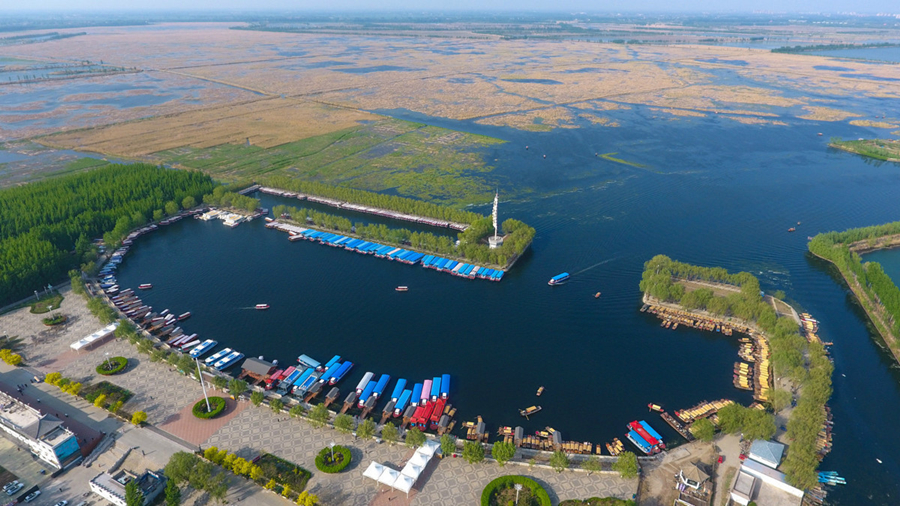Integrated development picks up speed

An aerial view of Baiyangdian Lake in Xiong'an New Area, Hebei province. [Photo by Liu Dongyao/For China Daily]
Early achievements
The integrated development of the Beijing-Tianjin-Hebei region has secured some early outcomes, especially in the integration of transportation networks.
In addition to the train between Beijing and Xiong'an, a high-speed railway line connecting Beijing and Zhangjiakou, the co-host city of the Beijing 2022 Winter Olympics, also began operating in late 2019.
Over the past seven years, a total of 32 expressways connecting cities in the region have been opened or expanded, stretching to a length of 2,005 kilometers.
In addition, Li's company has benefited from the integration drive.
His startup has benefited from Xiong'an's efforts to optimize its business environment, with the government outsourcing services to the company in areas such as the registration of new businesses and approvals for market access.
The company offered services to at least 1,500 companies that were registered in the new area and saw its turnover jump to 21 million yuan ($3.2 million) last year. It has also expanded its business scope from Xiong'an to Beijing's Haidian district, Tianjin and Hebei province.
"The growth of the new area is like the growing process of a human: It must first learn to crawl before walking and then competing on a racing track," Li said.
He added that the COVID-19 pandemic has not slowed the process of the area's development. Instead, a slew of landmark programs have been completed, and the public is starting to witness more tangible progress in its development.
"For the local residents, it is also a process of transitioning from farmers to urban dwellers, and they are starting to find opportunities for employment and starting new businesses," he said.
Zhou Jun, the founder and CEO of Beijing Eyecool Technology Co Ltd, a company that focuses on the development of biometric recognition technology, said the company's business has benefited from the integration of the three provincial-level areas, and especially from the development of Xiong'an.
The company relocated its headquarters from the capital to Xiong'an in 2018 in the belief that the area will be a smart city for the future.
"We realized that for artificial intelligence companies and the sector as whole, the development of the new area will be a historic opportunity," he said, adding that the company's multimodel biometric recognition technology fits strongly with the area's need to develop a smart city.
The company's technology has so far been applied to more than 20 innovation programs in Xiong'an, contributing to the development of a smart security system, parks, schools, relocation programs and the containment of COVID-19, he said.
"The building of smart parking facilities, street lamps and use of artificial intelligence in various areas has made the city smarter," he said.
Crucial period
Going forward, analysts said China's ongoing efforts to foster a new development paradigm and implement the 14th Five-Year Plan (2021-25) will provide stronger impetus to the integrated development of the three regions.
According to the plan, a set of new policies and programs will be launched to transfer Beijing's noncapital functions to areas including Xiong'an, which will see quicker development in the next five years.
The industry and innovation chains between Beijing, Tianjin and Hebei will be better integrated, and a rail transit network connecting the three areas will be completed.
The plan also highlighted the need to better coordinate measures in air pollution control and prevent excessive exploitation of groundwater in the region.
In Xi's latest remarks on the coordinated development of the region, which he made in January after inspecting the venues for the Beijing 2022 Winter Olympics and Paralympics, Xi urged more outcomes from areas including transportation, the environment, industries and public services in promoting the coordinated development of the three regions.
Zhang, the Renmin University professor, said the nation's efforts to foster a new development paradigm, with the domestic market as the mainstay and the domestic and international markets reinforcing each other, will provide the most important window of opportunity for the integration of the three areas.
A primary challenge will be reinforcement of the integrated growth of the industry, supply and innovation chains and the enabling of their optimized distribution in the three areas, he said.
To drive the integration of the region, Beijing must lead the coordinated development in the area and amplify its role as a center for innovation in science and technology, an international hub for consumption and the center for the digital economy, he added.
Ye Zhenyu, a researcher on regional economy with the Chinese Academy of Social Sciences, highlighted the importance of employing market methods in promoting the transfer of noncapital functions from Beijing.
The three areas must expand the coverage of high-quality public services with the development of emerging technologies, and must continue narrowing the divide in the level of public services, he said.
Li, from Jingxiong Group, said Xiong'an should offer talent policies, including in the areas of social security, housing, education and healthcare, to get more people to relocate to the new area.
"With sound urban planning in place and the fostering of an enabling environment, we have enough reasons to believe that Xiong'an will become a new growth engine and a city built with international standards," he said.
























